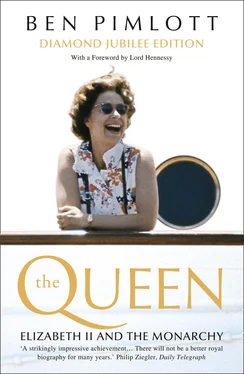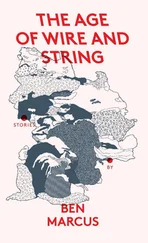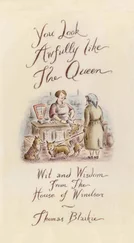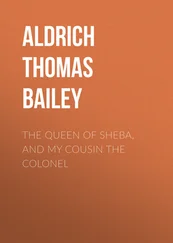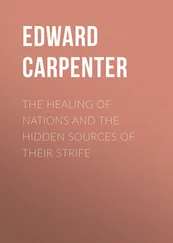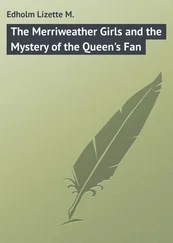The result was a painful period of transition, which expressed itself in bursts of undirected energy and dismissive intolerance. According to his manservant, ‘he loved the sea and adored the Navy, and some of my gayest times with him were when he was serving’. After his return from the sea, he was ‘inclined to be moody and impatient’, and it was some time before he settled down to public engagements. 1One of the butts of his impatience was the royal establishment, which he regarded as stuffy and old-fashioned. ‘Prince Philip was very hostile to Buckingham Palace – he didn’t like it, and he wanted his own show’, recalls a former courtier. ‘The gap between the Palace and Clarence House was very big.’ 2
It was some compensation that, by 1951, the much smaller households of the Princess and Duke at Clarence House did constitute a quite distinct show – and one that worked with a degree of efficiency and harmony that would have been impossible if they had stayed longer in the same building as the King and the Queen. It may have helped that at the beginning of 1950 the suavely intelligent Jock Colville returned to the Foreign Office. In some ways, Colville had been a progressive influence, with an ambition to make the Heiress and her husband more socially aware. On one occasion he even made the suggestion to the Duke that he should work as a coal miner for a month – a proposal which was rejected on the grounds that ‘it would be playing to the gallery’. 3Colville’s frequently possessive devotion to the Princess, however, had not made him the easiest of advisers for her husband to work with, and the atmosphere at Clarence House was more relaxed without him. His place was taken by Major Martin (later Lord) Charteris, a professional soldier who had spent much of the war in the Middle East, eventually running Military Intelligence in Palestine. Charteris worked for Elizabeth at Clarence House and then at Buckingham Palace for the next twenty-seven years. With the exception of her later Deputy Master of the Household, Lord Plunket, he came to know her as well as any courtier. His particular blend of wisdom, dry humour, friendliness, conservatism and selfless loyalty fitted her needs well.
Those who worked at Clarence House in the short period of its occupancy by the royal couple recall a happy, close-knit group of helpers, over which the influence of the busy and contented Princess, enjoying her duties and her pleasures, shone benignly. ‘Martin and I both loved to bask in her light’, says Mike Parker. ‘She was very good at making you feel part of her team and family.’ 4The mornings would be filled with letters and other business, the afternoons with visits. She and her husband would often lunch with the staff in the dining-room, in conditions that were less formal and much more intimate than anything possible at the Palace. 5
‘When we were planning daytime journeys, she was very good at making suggestions’, Parker recalls. ‘She showed an early maturity in discussing things and making decisions.’ 6Her responsibilities were widening. As yet, however, she had little knowledge of the conduct of Government business. Jock Colville had made his own contribution, by persuading the Foreign Secretary to let her see Foreign Office telegrams. In the summer of 1950, Charteris took a leaf out of Colville’s book, and raised with the Cabinet Secretary, Sir Norman Brook, the possibility of letting her see Cabinet papers as well. Brook consulted the Prime Minister, suggesting that the Princess should see minutes as well as memoranda, apart from any Confidential Annexes, as ‘a temporary experiment forming part of the general plan for giving Her Royal Highness a wider experience of public affairs’. 7Attlee spoke to the King. Then he scribbled a note to Brook: ‘I think it should be permanent’, and it became so. 8
The Princess’s experience of public affairs extended in other, more traditional ways over the next eighteen months. In 1951 – year of the Festival of Britain – the Royal Family was in exceptional demand for ceremonial duties, and Elizabeth had to deputize for her father, because of his illness, on many occasions. In June, she hosted a dinner for her uncle, King Haakon of Norway. This time her father was too ill to attend the King’s Birthday Parade of the Brigade of Guards, with the ceremony of Trooping the Colour, on Horse Guards Parade. It was a vivid début . The tiny, compact figure, riding side-saddle in the scarlet tunic of Colonel of the Grenadiers – ‘a woman alone’, as The Times put it, at the centre of an all-male military event – was a telling reminder of her significance, not just as under-study, but as successor to the sick Monarch. 9
In the summer, the medical suspicion that George VI had cancer became stronger. In September, exploratory surgery confirmed it, and the King underwent the removal of his left lung. Once the severity of the illness was established, a variety of arrangements had to be made. To ensure that the constitutional functions of the Monarchy should continue without interruption, Lascelles took the necessary steps to have the Queen, the two princesses, the Duke of Gloucester and the Princess Royal designated Counsellors of State. Princess Elizabeth wrote to her father’s private secretary agreeing that this was the best thing to do, ‘for it will relieve the King of so much of the ordinary routine things’. 10
One routine thing was the general election. Before the operation, the King had asked the Prime Minister to make a decision about a poll before the start of his Commonwealth tour, planned for January. After it, Lascelles wrote to Attlee explaining that when this request had been made, the King had had no inkling that the trip would have to be put off. 11The decision was now taken to hold an election on October 15th. On October 4th, Princess Elizabeth presided over the Privy Council preceding the Dissolution. Meanwhile she had been making her own preparations. ‘In view of the unfortunate turn in the King’s health,’ she wrote to her young dress designer Hardy Amies on September 24th, and ‘in the strictest confidence . . . I have strong reason to believe that he will be unable to undertake the tour of Australia and New Zealand. I would very much like you to prepare some sketches for me to see . . . as a precaution against any sudden decision for us to go in the King’s place.’ 12On October 9th, the King’s already postponed South Sea tour was cancelled.
It was to be a busy winter – the busiest, indeed, of the Princess’s life so far. Despite anxiety about the King, she and her husband decided to go ahead with a long-projected tour of Canada. This particular venture had first been mooted three years earlier. Elizabeth had been keen, but – as over the French trip – Philip had initially been opposed, saying that he wanted to settle down and start a family. 13Their family was now well started and they had, at Clarence House, a settled home. With the other obstacle – Philip’s naval duties – also removed, the trip was scheduled for October 1951. Meanwhile, the proposed tour had expanded in ambition. The visit had at first been envisaged as a purely Commonwealth undertaking. However, in July, Lord Halifax – a former ambassador in Washington – had suggested that it would be impolite for the royal couple not to include in their itinerary a brief detour south of the border. So what Lascelles called a ‘pop-over’ holiday visit to the United States was tacked on, as an extra. 14The royal party flew out to Newfoundland on October 7th, for a tour that was overshadowed by fears for the King’s health. To guard against the possibility of his death, Charteris kept papers about the holding of an Accession Council under his bed throughout the trip. 15
They had a mixed reception. A few days after their arrival, the Canadian Governor-General wrote soothingly to the King that the Quebecois had been impressed by the Princess’s French, and that the crowds in Ottawa were bigger than those during the state visits of either President Truman or President Auriol of France. 16However the press – unaware of the seriousness of the King’s illness and looking for an angle – quickly decided that the Princess looked distracted, and even bored. ‘At the end of some of the long trying days,’ declared one Canadian broadcaster, ‘you’d hear people worrying about how tired the Princess is.’ 17The royal party had an uncomfortable feeling of the trip having got off to a poor start. ‘There was a lot of comment about Princess Elizabeth not smiling,’ according to Lord Charteris. It was to become a common complaint. ‘My face is aching with smiling,’ he recalled her saying in exasperation. 18Yet there was no lack of interest. Such was the crush of photographers wanting to get a picture of her face, smiling or blank, that splinters of glass from exploding flash bulbs were found on her coat. 19
Читать дальше
